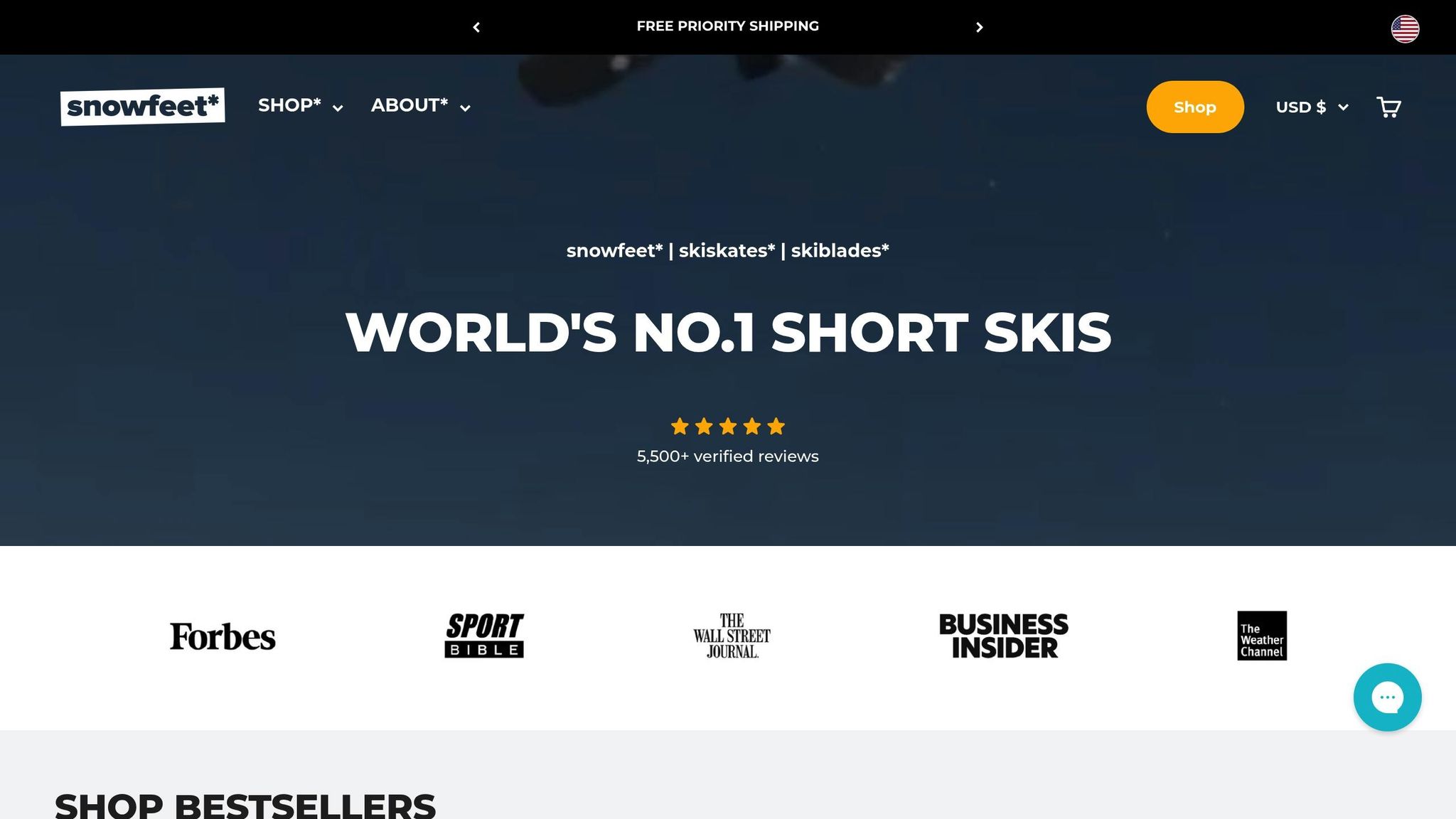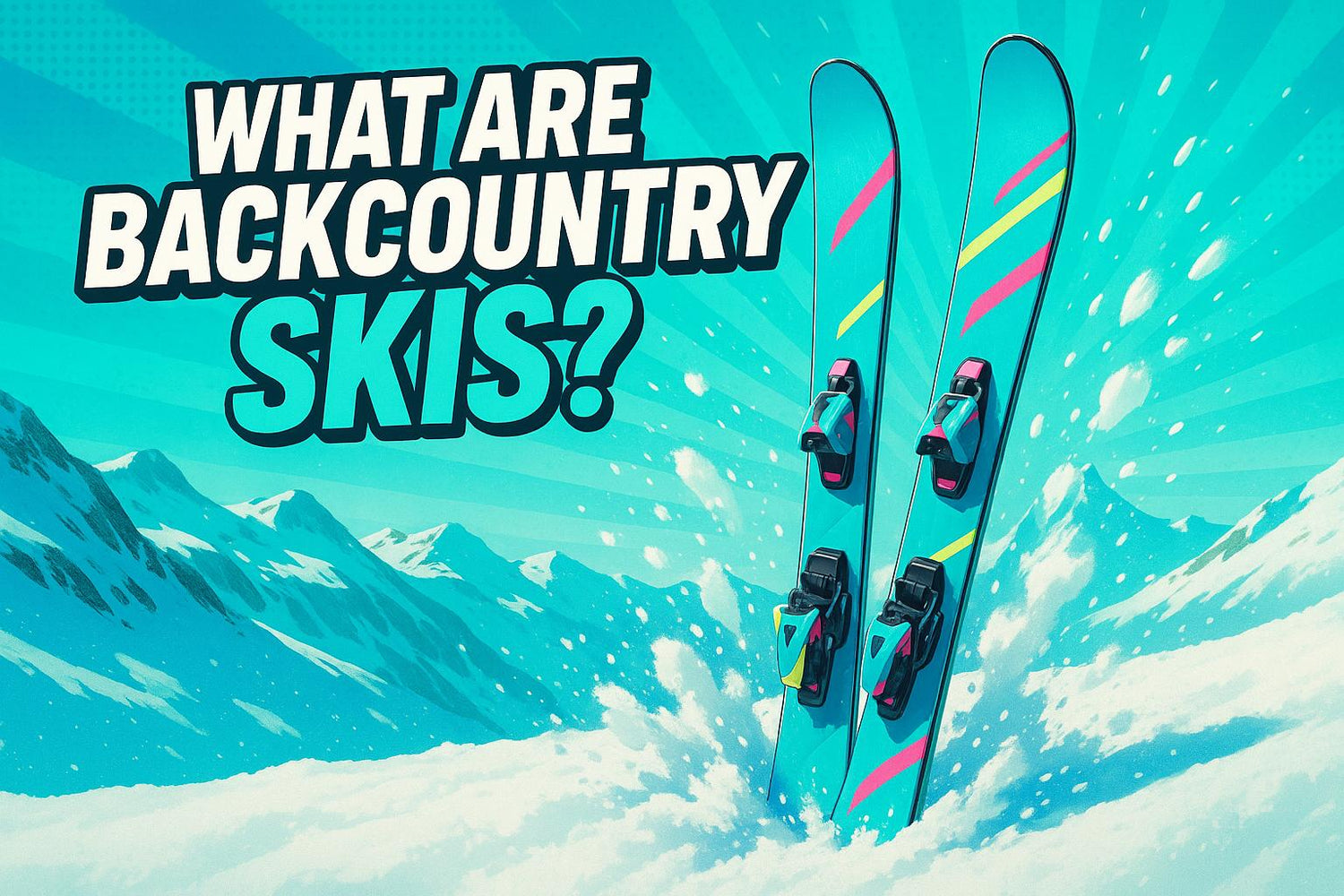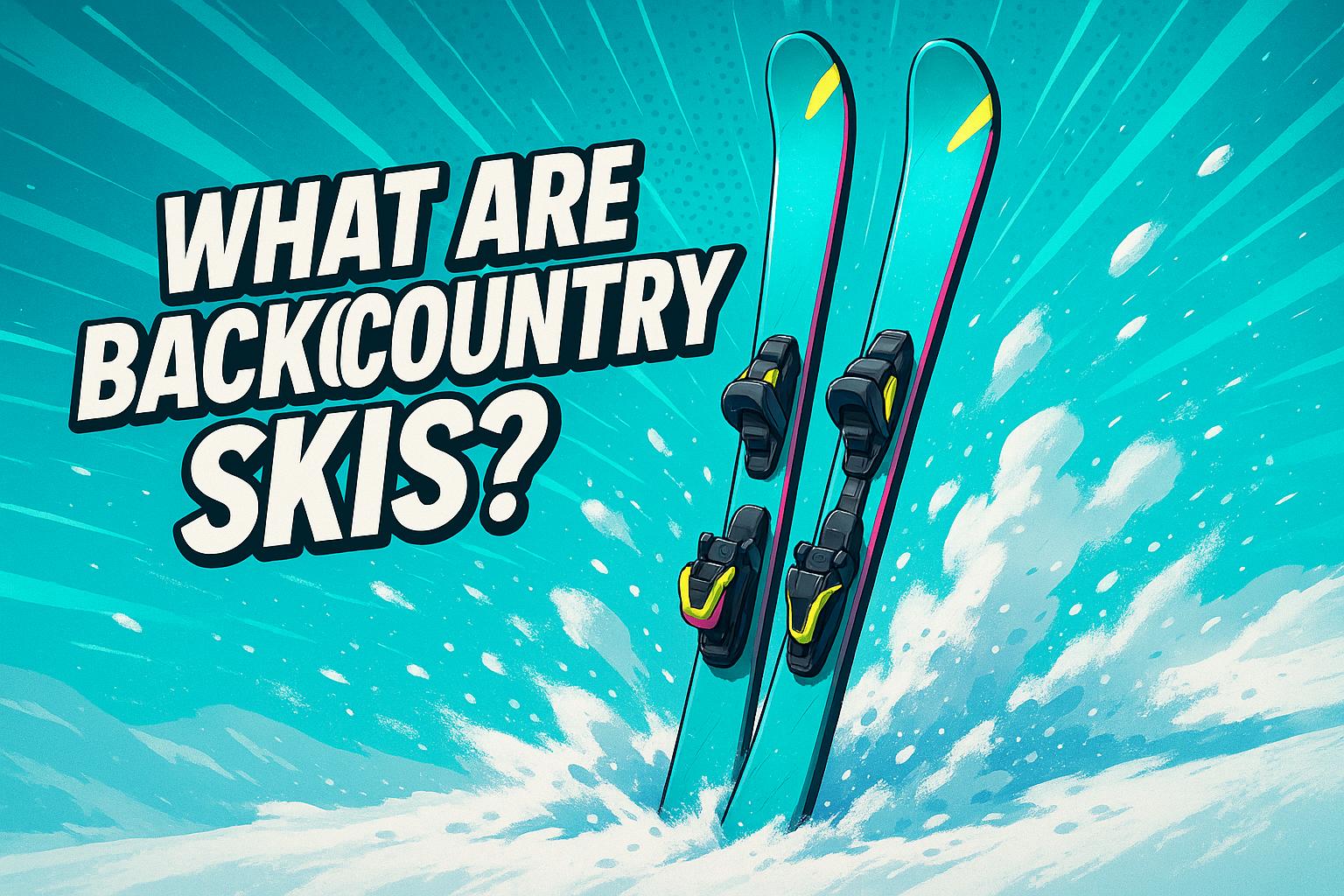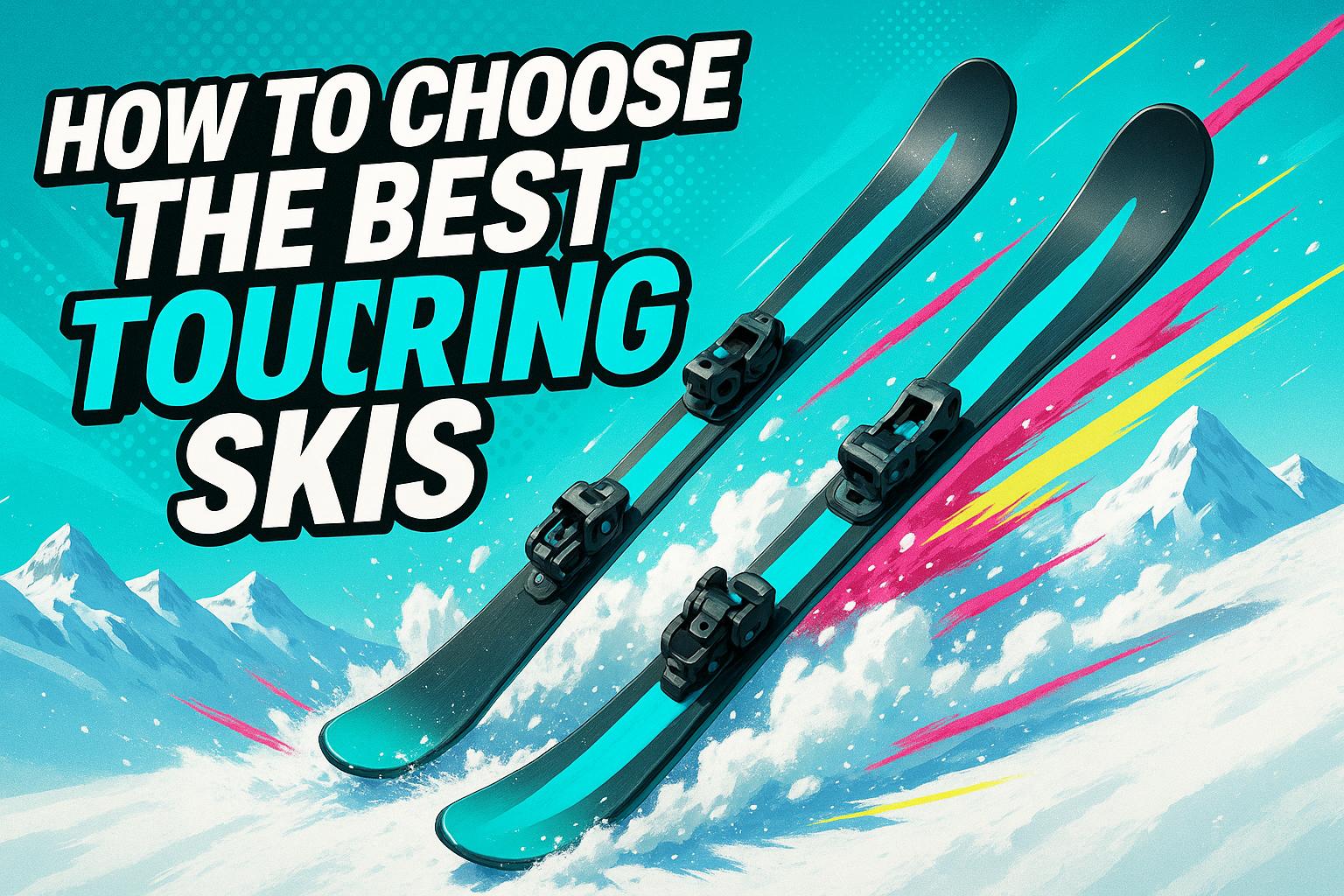Backcountry skiing is all about leaving resort crowds behind and exploring untouched snow. But what makes backcountry skis different? They're designed for rugged terrain, with features like lightweight builds, metal edges, and special shapes for better control on uneven snow. And now, brands like Snowfeet* are changing the game with compact, beginner-friendly options like the 100 cm WALKSKI.
Key Takeaways:
- Why it's growing: A 16% rise in ski touring (2022-23) shows more people are ditching resorts for nature.
- Who it's for: From beginners to pros, backcountry skiing offers something for everyone - freedom, fun, and adventure.
- Gear to know: Snowfeet* WALKSKI is a lightweight, easy-to-use option that fits in a backpack and works with regular winter boots.
Ready to hit the slopes? Let’s break it all down.
Key Features and Benefits of Backcountry Skis
Technical Features: Rocker, Camber, and Sidecut
When it comes to backcountry skis, the technical details make all the difference. Features like camber, sidecut, rocker, and taper work together to enhance performance across different terrains.
Camber refers to the ski's natural upward curve when unweighted. This design improves grip on firm snow and provides a spring-like energy return, boosting performance. On groomed trails, a pronounced camber offers better stability, while a lower camber is ideal for soft, powdery snow.
Sidecut is the difference in width between the ski's narrowest point underfoot and its wider tip and tail. This shape influences the turning radius - greater sidecut allows for quicker, sharper turns, while a gentler sidecut supports longer, more gradual arcs.
Rocker has transformed skiing. By curving the tips and tails upward, rocker profiles improve float in powder and make the skis easier to maneuver in mixed conditions. Depending on the rocker design, you can prioritize either agility or stability.
Lastly, taper adds versatility by letting skiers manage turn shapes independently of the sidecut. This feature is especially handy in backcountry settings where snow and terrain can change in an instant.
These design elements work together to ensure reliable performance, even in the unpredictable conditions of the backcountry.
Lightweight Design for Better Efficiency
In backcountry skiing, every gram counts. Long uphill climbs and carrying gear can be exhausting, so lightweight skis are a game-changer. Skis weighing under 1,600 grams each (without bindings) are ideal, and small weight differences - less than 100 grams - are usually negligible.
This is where Snowfeet* shines. Their 100 cm skis are lighter and more compact than traditional options from brands like Rossignol, Atomic, Head, and Elan. These short skis not only reduce weight but also offer incredible mobility and responsiveness. Many users rave about their experience:
"Easily one of the best purchases I have ever made to date." – Vanessa, UK
"Absolute game-changer! They're light, fast, and incredibly fun to ride." – Nathan F.
Aside from weight savings, the compact design of Snowfeet* eliminates the hassle of bulky gear and storage issues. For adventurers who value portability and fun without compromising performance, Snowfeet* is a standout choice.
Gear Integration and Multi-Purpose Use
Backcountry skiing often requires specialized equipment, but Snowfeet* takes a different approach. These skis are designed for versatility, working seamlessly with various types of winter footwear. This means you can skip the investment in expensive, highly specialized boots.
The bindings on Snowfeet* are adjustable and feature an anti-slip design, making them adaptable to different sizes and secure for all-day use. Their flexibility allows you to enjoy them on cross-country trails, sledding hills, or even in your own backyard. Essentially, any snow-covered slope becomes your personal playground.
Their compact and lightweight build also makes them easy to pack for hikes or winter camping. Unlike traditional backcountry gear from brands like Head or Elan, Snowfeet* doesn’t require advanced skills or lessons. They’re beginner-friendly and accessible, opening up backcountry adventures to skiers of all levels.
Who Should Use Backcountry Skis?
Adventure Skiers and Outdoor Enthusiasts
Backcountry skiing draws in those who yearn for the thrill of untouched snow and the freedom to explore beyond resort boundaries. If you're over the crowds, lift lines, and carefully groomed runs, backcountry skis offer a chance to carve your own path in pristine, untouched terrain.
For adventure seekers, this type of skiing is about more than just the sport - it's about connecting with nature. Imagine gliding through fresh powder, discovering hidden valleys, and soaking in the quiet beauty of the wilderness. Without marked trails or set routes, every outing becomes its own unique journey.
For those who value portability and spontaneity, Snowfeet* WALKSKI is a game-changer. These compact skis fit easily into a backpack, making them perfect for winter hikes, camping trips, or even a quick session on a local hill. No need to plan elaborate trips or rely on ski resorts - this flexibility makes them an appealing choice for skiers of all levels.
Beginners to Experts: A Sport for Everyone
There's a myth that backcountry skiing is only for seasoned experts, but that's far from the truth. While traditional gear from brands like Rossignol or Atomic can require advanced skills, Snowfeet* makes backcountry skiing far more approachable.
For beginners, the design of Snowfeet* takes away much of the intimidation. With a length of just 99 cm, these skis are easier to handle than the typical 150–180 cm models. As the Snowfeet team puts it:
"Short skis are easier to handle and offer better control, which makes them the perfect choice for beginners and intermediates."
– Snowfeet Store
The bindings are another win - they work with any winter shoes or snowboard boots, so there's no need to invest in expensive, specialized ski gear. This makes it easy for newcomers to dip their toes into backcountry skiing without a big upfront cost.
Intermediate skiers love the shorter length too. It makes navigating tight spaces, trees, and unpredictable snow much simpler. Even seasoned skiers find value in Snowfeet*, as the design encourages creativity and enhances confidence on challenging terrain.
For those just starting out, experts recommend forgiving skis - typically with a width of about 100–105 mm underfoot and weighing between 1,500 and 1,700 grams per ski. Snowfeet* WALKSKI fits this description perfectly, making it an ideal starting point for backcountry adventures. But remember, backcountry skiing comes with its own set of physical and safety challenges that you'll need to prepare for.
Requirements for Backcountry Skiing
While Snowfeet* makes the transition to backcountry skiing easier, it’s important to understand the added demands of venturing away from the resort. Physical fitness plays a huge role, as up to 90% of backcountry skiing involves uphill climbs, which can be physically taxing. The lightweight design of Snowfeet* helps reduce this strain compared to heavier, traditional setups.
Avalanche safety is non-negotiable. Richard Bothwell, a former Executive Director of the American Institute for Avalanche Research and Education, stresses the importance of preparation:
"Skiers need more than just avalanche training. Skiers should also have a solid working knowledge of their gear and how to fix things when they break."
– Richard Bothwell
Before heading into avalanche-prone terrain, complete a certified avalanche safety course. It’s also crucial to be comfortable skiing in a variety of snow conditions, weather scenarios, and terrains. Snowfeet*’s forgiving design can help you build those skills with confidence.
Don’t skip over navigation and communication skills either. Start small - stick to low-risk areas near established trails and practice with your gear in controlled settings. As your experience grows, you can gradually tackle more challenging terrain. Backcountry skiing is as much about preparation as it is about adventure, and taking these steps ensures you'll enjoy the journey safely and confidently.
Backcountry Skiing Basics: Gear & Technique | Beginners Guide
Snowfeet* WALKSKI vs. Standard Backcountry Skis and Snowboards

Snowfeet* WALKSKI* bring a fresh approach to backcountry gear, standing out from traditional options like those from Rossignol, Atomic, and Head.
Comparison Table: Snowfeet* vs Standard Gear
| Feature | Snowfeet* WALKSKI | Standard Backcountry Skis | Snowboards (Splitboards) |
|---|---|---|---|
| Weight | Under 2.2 lbs per ski | 3.3–4.4 lbs per ski | 5.5–7.7 lbs per board |
| Length | 39 inches (100 cm) | 63–75 inches (160–190 cm) | 55–67 inches (140–170 cm) |
| Portability | Fits in a backpack | Requires ski bag/roof rack | Requires board bag/roof rack |
| Boot Compatibility | Any winter boots | Specialized ski boots only | Snowboard boots only |
| Learning Curve | Beginner-friendly | Moderate to steep | Moderate |
| Price Range | $300–$400 | $500–$1,200+ (skis only) | $700–$1,500+ |
| Storage | Closet-friendly | Garage/basement space | Garage/basement space |
| Best Terrain | Mixed, forest, rolling hills | Powder, steep, open slopes | Powder, open terrain |
This table highlights how Snowfeet* WALKSKI* combine portability, lightweight design, and affordability in ways that traditional gear just can't match. Sure, some ultralight backcountry skis weigh under 3.3 lbs per ski, but most fall between 3.3–4.4 lbs. Snowfeet* WALKSKI* slash that weight, making uphill climbs and transport much easier.
When it comes to cost, traditional gear can be a hefty investment. A full setup - skis, bindings, boots, and skins - from brands like Elan or Head can run you $1,500–$2,000. Add maintenance and repairs, and the expenses keep piling up. Snowfeet* WALKSKI* offer a more wallet-friendly alternative, fitting seamlessly into the fast-paced, adventurous spirit of today’s backcountry lifestyle.
Why Snowfeet* Offers More Freedom and Fun
Snowfeet* WALKSKI* aren’t just about saving weight or money - they’re about rethinking what backcountry skiing can be. For years, the mantra has been "longer skis equal better performance", but Snowfeet* flip that idea on its head. At just 39 inches long, they prove that shorter, lighter skis can deliver a whole new level of freedom and fun.
Think about the practical side. With Snowfeet*, you can toss them in your car trunk and head out for a spontaneous weekend trip. Compare that to lugging around standard backcountry skis from Atomic or Rossignol, which require roof racks and more planning. Their compact size also lets you tackle terrain that’s off-limits to longer skis - tight forest trails, rolling hills, and mixed conditions where agility matters more than speed.
Another game-changer? Boot compatibility. Instead of shelling out for pricey ski boots that only work with specific bindings, Snowfeet* WALKSKI* pair with any winter boots you already own. This flexibility makes backcountry skiing more accessible to people who might have been put off by the typical gear requirements.
Snowfeet* shine in rolling, forested, and mixed terrain - places where nimbleness is key. While traditional backcountry skis and snowboards dominate in deep powder and steep alpine descents, they’re not as adaptable to the varied conditions most recreational skiers face.
What really sets Snowfeet* WALKSKI* apart is their versatility. They’re not just for skiing - you can use them for hiking and snowshoeing too, all in the same outing. This multi-purpose design makes them perfect for micro-adventures and exploring mixed terrains, aligning with the growing trend of blending activities in the backcountry world.
Traditional skis and snowboards still have their place in deep powder and steep descents. But Snowfeet* WALKSKI* bring something new to the table: portability, accessibility, and the freedom to ski wherever, whenever. They’re not here to replace your gear - they’re creating a whole new way to enjoy winter adventures.
Choosing the Right Backcountry Ski for Your Needs
Picking the right backcountry skis comes down to understanding your skiing style, the terrain you plan to explore, and your skill level. Your gear should match your adventures, ensuring both fun and safety out in the wild.
Factors to Consider: Length, Width, and Profile
When it comes to skis, the details matter. Here's a quick breakdown of what to keep in mind:
- Length: Longer skis are great for stability, while shorter ones are easier to control and maneuver, especially in tight spots.
- Weight: If you're climbing a lot, lighter skis will save your legs. On the flip side, heavier skis can give you more stability when you're cruising downhill.
- Width: Think about the snow you'll encounter. Wider skis float better in deep powder, while narrower ones grip and respond better on hard-packed snow.
Your skill level is another key factor. Advanced skiers might lean toward stiffer skis that demand precision, while beginners will appreciate softer, more forgiving options that are easier to handle. Be honest about where you're at - choosing the wrong gear can lead to frustration (and maybe a few extra tumbles).
Snowfeet* Product Lineup: Compact Options
Now, let’s talk about Snowfeet*. They’re shaking things up with their compact take on backcountry skiing. Their lineup includes:
- WALKSKI (100 cm): $490
- Skiblades (99 cm): $490
- Skiskates (44 cm): Starting at $390
- Mini Ski Skates (38 cm): $150
- Short Skis (120 cm): $690
All these options are compatible with your regular boots, so no need to splurge on special footwear.
"Walkski are much shorter and lighter than traditional backcountry skis, making them easier to carry and control. Their compact size allows you to navigate narrow trails and climb steep slopes with less effort, while still offering smooth downhill performance."
– Snowfeet* WALKSKI FAQ
Required Accessories and Maintenance Tips
Backcountry skiing isn’t just about the skis - you’ll need the right accessories and some TLC for your gear.
- Climbing Skins: Essential for uphill travel. Mohair skins are lighter and glide smoothly, while nylon skins offer more grip and durability.
- Bindings: Tech bindings are lightweight and ideal for backcountry use. Frame bindings, though heavier, provide better control on descents.
Snowfeet* simplifies things here, too. Their bindings are easy to adjust at home, so you can skip the extra hassle.
Maintenance is key to keeping your gear in top shape. Regularly wax your skis for better glide, sharpen the edges to maintain performance, and always dry them thoroughly to avoid rust. This applies whether you’re using traditional brands like Head or Atomic, or Snowfeet*’s compact designs.
And don’t forget your safety gear. Avalanche transceivers, probes, and shovels are must-haves for backcountry adventures. If you’re unsure about your setup, consider attending a local demo day to try out different gear combinations. It’s a great way to find what works best for your style and the terrain you’ll be tackling.
Snowfeet*’s approach makes backcountry skiing more accessible. While traditional setups can be pricey and require a lot of know-how, Snowfeet* offers a simpler, more affordable way to hit the slopes. It’s all about cutting down the complexity so you can focus on enjoying the ride.
sbb-itb-17ade95
Conclusion
Backcountry skiing saw a 16% rise in ski touring participation during the 2022–23 season compared to the previous year. It’s easy to see why - escaping the crowds, pushing your limits, and immersing yourself in nature offers an experience that traditional resorts just can’t match.
Enter Snowfeet*. This brand is shaking things up in the backcountry skiing world. While traditional setups from big names like Rossignol, Atomic, and Head can set you back over $2,200, the Snowfeet* WALKSKI is priced at just $499. That’s a game-changer for making the sport more accessible.
What makes Snowfeet* stand out? Simplicity. You don’t need specialized boots, years of practice, or a big budget. The 100 cm WALKSKI works with your regular winter boots and is lightweight enough to carry with ease.
This design isn’t just for one type of skier - it’s for everyone. Whether you’re new to the slopes or a seasoned pro looking for a compact, fun alternative, Snowfeet* opens the door to backcountry skiing without the usual hassle or cost. It’s about turning a sport once dominated by pricey, complicated gear into something anyone can enjoy.
As backcountry skiing continues to grow, innovations like Snowfeet* are helping more people experience the thrill. And at the heart of it all, it’s not just about the equipment - it’s about the freedom to explore untouched snow and carve your own path through the mountains. With shorter, lighter skis, you can focus on the adventure, not on managing bulky gear.
FAQs
How do Snowfeet* WALKSKI backcountry skis compare to traditional skis in performance and versatility?
Snowfeet* WALKSKI: Lightweight Backcountry Skis for Adventurers
Snowfeet* WALKSKI backcountry skis are designed for adventurers who want gear that's lightweight, portable, and easy to handle. Unlike traditional backcountry skis from brands like Rossignol or Atomic - which are built for long tours or groomed slopes - WALKSKI skis are compact and perfect for quick trips into rugged, off-the-beaten-path terrain. At just 100 cm in length, their small size and lightweight design make them incredibly agile, especially in tight spots or on uneven ground.
While traditional skis excel on groomed trails or steep descents, WALKSKI skis focus on convenience and versatility. They're simple to set up, easy on the knees, and made for skiers who value portability and efficiency over the bulk of performance-heavy gear. Whether you're venturing off-piste or navigating mixed terrain, WALKSKI skis strike a balance between practicality and adventure, catering to the needs of modern outdoor enthusiasts across the U.S.
What safety tips should beginners know before trying backcountry skiing with Snowfeet*?
Staying Safe While Backcountry Skiing with Snowfeet
If you're just getting started with backcountry skiing using Snowfeet, safety should be your top priority. Always wear a helmet and proper protective gear to reduce the chance of injuries. Since Snowfeet are built for flat or gently sloped terrain rather than steep or high-speed runs, stick to beginner-friendly areas while you're learning the ropes.
It's equally important to brush up on basic avalanche safety if you're heading into more remote spots. Learn how to use essential tools like beacons, shovels, and probes. Snowfeet’s compact design makes them easy to manage and great for picking up skills quickly, but don’t let that lure you into risky or unfamiliar terrain. Stay aware of your surroundings, start slow, and focus on safety. That way, you can fully enjoy the fun and flexibility that Snowfeet bring to your adventures!
Are Snowfeet* WALKSKI backcountry skis suitable for different terrains and snow conditions, and how do they compare to traditional longer skis?
Snowfeet* WALKSKI Backcountry Skis: Compact and Ready for Adventure
Snowfeet* WALKSKI backcountry skis are built to handle just about any snowy terrain you can throw at them - powder, packed trails, or even uneven surfaces. Thanks to their compact 100 cm length and lightweight design, they’re super easy to maneuver, especially in tight or tricky spots. This makes them a fantastic choice for adventurous skiers and outdoor lovers who want snow gear that’s portable and efficient without compromising on performance.
When compared to traditional longer skis from brands like Rossignol or Atomic, Snowfeet* WALKSKI skis bring some unique advantages to the table. While longer skis might shine when it comes to high-speed stability and tackling deep powder, the shorter length of the WALKSKI skis offers quicker, more responsive handling. Plus, their lightweight build makes them a breeze to carry around, which is a big win for backcountry explorers. If you’re all about gear that’s easy to pack, versatile, and still delivers solid performance, Snowfeet* WALKSKI skis are tough to beat.


































Leave a comment
This site is protected by hCaptcha and the hCaptcha Privacy Policy and Terms of Service apply.